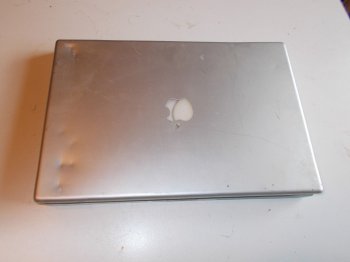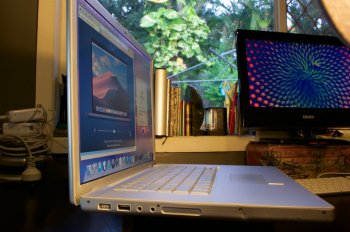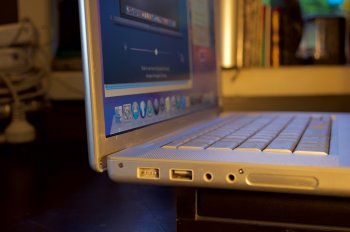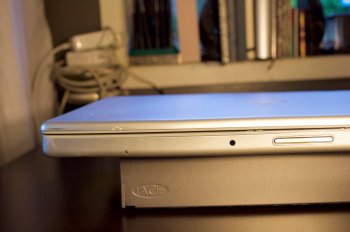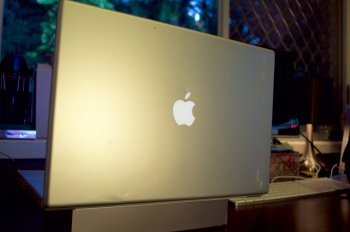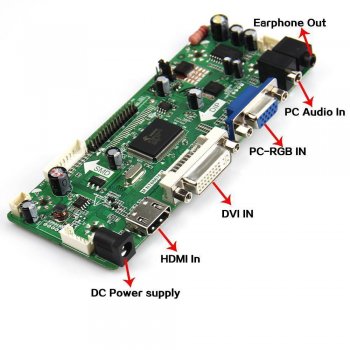Trash or treasure?
In follow up to our Early Intel thread, I just wanted to share a story about this treasure of a Core 2 Duo which I was able to salvage.
I recently took a gamble on this rough looking Mac...
I had no idea which model it was or the severity of the smashed screen. But I made an offer and it was accepted with free shipping for AU$27 (this works out to be about the cost of a fish and chips dinner for my British friends).
When the unit arrived, the display was in shocking condition. It was bulging out, the top panel's inner plastic frame was completely lifted off and snapped in several places. The LCD panel was completely bent out of shape and as you can imagine, it was broken into shards. The display also had no hope of closing, let alone latching. The front bezel was warped and the hinge mounts on the frame were about 30° out of alignment.
It looked like someone sat a heavy book on top of the keyboard and then decided to sit themselves directly back onto the screen... (essentially folding it over)
Initial inspection.
Initially, I couldn't get it to power on, so I put it aside for a few days. Then with the advice of @LightBulbFun, I tried first installing a charged battery, instead of attempting to boot from the 60w MagSafe charger borrowed from my MacBook. The MBP uses the 85w MagSafe adapter which I don't have on hand.
Pressing the power button resulted in a happy chime and I promptly connected a display to the wonderfully full-sized DVI port on the side which Apple have generously provided us with since the Titanium PowerBook days. I believe this particular MacBook Pro was the last to feature a DVI port.
So, I wiped the machine down with a damp cloth and tried to man handle the display frame back into shape for a photo opportunity.
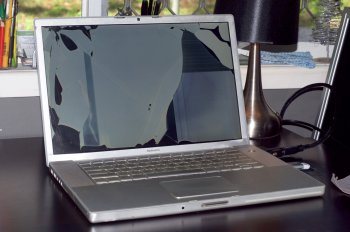
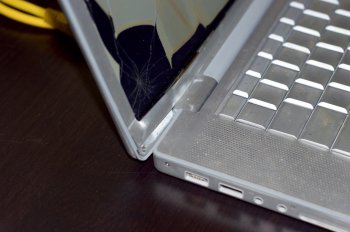
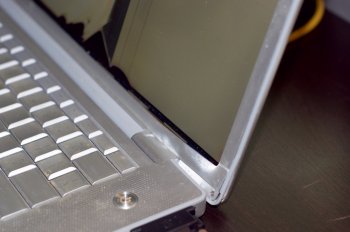
(It doesn't look terrible while it's running, but as soon as I tried closing the lid, the layers of the display assembly splayed right out)
The MacBook Pro then booted into the previous owner's desktop, along with a DVD movie still in the drive. (their personal files are blurred out for privacy)
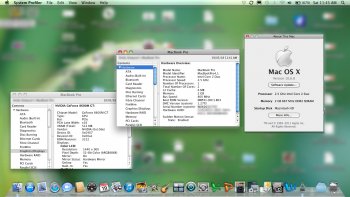
The specs are not bad at all!
Operating Systems
Needless to say I was impressed with the specs and went about setting up the hard drive with 8 partitions to install a series of different Mac OS X iterations going right back to the beginning of Intel support;
It is very cool to have a Mac which can boot into so many different systems. It also becomes very obvious when running Yosemite and El Capitan that an SSD and at least 4GB of RAM is needed. Both systems begin to bog right down very fast.
Repairing the MacBook Pro
I was hunting around on eBay for a complete display assembly to just replace the entire top half of the laptop, but prices (in Australia) are still relatively high for this model. I found a supplier of low-cost replacement LCD panels and scored a matching AU Optonics Model B154PW04 V.0 LED backlit LCD Panel. The seller accepted my offer of AU$25 + shipping and promptly sent it to me.
When the brilliantly clean, unused panel arrived, I went about installing it. Dismantling the display assembly is a piece of cake on these pre-unibody MacBook Pros. It is an identical technique to pulling apart the displays on the Aluminum PowerBooks (and even the white iBook G3 & G4). It really is a shame the more recent models can't be easily serviced like this.
While I had the display bezel/frame out of the Mac I tried roughly reshaping the hinges by hand, but the thin bezel had already developed a kink and began to tear through with any added motion. I settled on just attempting to use the structural integrity of the LCD panel to re-form the shape of the bezel and unfortunately I put too much pressure on the lower left hand corner of the screen and heard a *crack*.. Ooops. I just cracked my new panel!
Kicking myself, I went back to the seller and made the same offer again for another panel, which once again he promptly sent out.
When the 2nd replacement panel arrived, I stripped the MacBook Pro down again. This time, I pulled out every component (drives, logic board, I/O board, etc) as well as fully dismantling the display assembly. I had the whole machine strewn out across my workbench and also on the floor. I decided I would try re-forming the aluminum frame using some tools;
Using my multi-purpose 2-part epoxy, I then glued in small strips of thin stainless steel reinforcements behind the display bezel at the point where the aluminum had begun to soften. There isn't a lot of room here, the little strips I had came out of another computer at some stage (I can't recall), but they would be about 0.5mm thick and 10mm x 4mm in size.
While I had the logic board out, I took the opportunity to clean out the dust from the fans and heatsink, as well as clean off the 10 year old thermal paste.
Here are some macro shot of the CPU, bus controller and GPU;
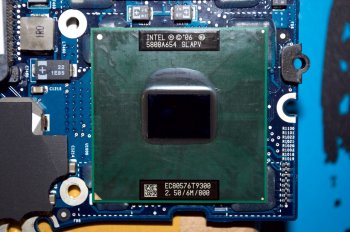
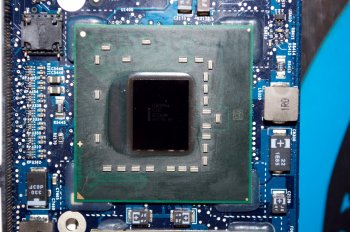

These IHS dies were re-pasted with Grizzly Kryonaut 12.5w/mk compound and all was re-assembled.
And the results? Stay tuned... (uploading more photos).
In follow up to our Early Intel thread, I just wanted to share a story about this treasure of a Core 2 Duo which I was able to salvage.
I recently took a gamble on this rough looking Mac...
I had no idea which model it was or the severity of the smashed screen. But I made an offer and it was accepted with free shipping for AU$27 (this works out to be about the cost of a fish and chips dinner for my British friends).
When the unit arrived, the display was in shocking condition. It was bulging out, the top panel's inner plastic frame was completely lifted off and snapped in several places. The LCD panel was completely bent out of shape and as you can imagine, it was broken into shards. The display also had no hope of closing, let alone latching. The front bezel was warped and the hinge mounts on the frame were about 30° out of alignment.
It looked like someone sat a heavy book on top of the keyboard and then decided to sit themselves directly back onto the screen... (essentially folding it over)
Initial inspection.
Initially, I couldn't get it to power on, so I put it aside for a few days. Then with the advice of @LightBulbFun, I tried first installing a charged battery, instead of attempting to boot from the 60w MagSafe charger borrowed from my MacBook. The MBP uses the 85w MagSafe adapter which I don't have on hand.
Pressing the power button resulted in a happy chime and I promptly connected a display to the wonderfully full-sized DVI port on the side which Apple have generously provided us with since the Titanium PowerBook days. I believe this particular MacBook Pro was the last to feature a DVI port.
So, I wiped the machine down with a damp cloth and tried to man handle the display frame back into shape for a photo opportunity.



(It doesn't look terrible while it's running, but as soon as I tried closing the lid, the layers of the display assembly splayed right out)
The MacBook Pro then booted into the previous owner's desktop, along with a DVD movie still in the drive. (their personal files are blurred out for privacy)

The specs are not bad at all!
- 2.5Ghz Core 2 Duo
- 6MB L2 cache
- 800Mhz system bus
- 2GB of RAM
- 512MB Nvidia 8600M GT
- 250GB HDD.
Operating Systems
Needless to say I was impressed with the specs and went about setting up the hard drive with 8 partitions to install a series of different Mac OS X iterations going right back to the beginning of Intel support;
- Mac OS X 10.4 Tiger (10GB partition)- Cloned from an installation made from a MBP3,1 disc, installed onto a MBP1,1 as I've outlined here)
- Mac OS X 10.5 Leopard (20GB) - Easy installation from my trusty Firewire iPod 3rd gen Leopard install drive. This works seamlessly across both the PowerPCs and the early Intels.
- Mac OS X 10.6 Snow Leopard (22GB) - Couldn't be simpler with the retail DVD - pop it in and install.
- Mac OS X 10.7 Lion (22GB)
- Mac OS X 10.8 Mountain Lion (22GB)
- Mac OS X 10.9 Mavericks (30GB)
- Mac OS X 10.10 Yosemite (40GB)
- Mac OS X 10.11 El Capitan (65GB)
It is very cool to have a Mac which can boot into so many different systems. It also becomes very obvious when running Yosemite and El Capitan that an SSD and at least 4GB of RAM is needed. Both systems begin to bog right down very fast.
Repairing the MacBook Pro
I was hunting around on eBay for a complete display assembly to just replace the entire top half of the laptop, but prices (in Australia) are still relatively high for this model. I found a supplier of low-cost replacement LCD panels and scored a matching AU Optonics Model B154PW04 V.0 LED backlit LCD Panel. The seller accepted my offer of AU$25 + shipping and promptly sent it to me.
When the brilliantly clean, unused panel arrived, I went about installing it. Dismantling the display assembly is a piece of cake on these pre-unibody MacBook Pros. It is an identical technique to pulling apart the displays on the Aluminum PowerBooks (and even the white iBook G3 & G4). It really is a shame the more recent models can't be easily serviced like this.
While I had the display bezel/frame out of the Mac I tried roughly reshaping the hinges by hand, but the thin bezel had already developed a kink and began to tear through with any added motion. I settled on just attempting to use the structural integrity of the LCD panel to re-form the shape of the bezel and unfortunately I put too much pressure on the lower left hand corner of the screen and heard a *crack*.. Ooops. I just cracked my new panel!
Kicking myself, I went back to the seller and made the same offer again for another panel, which once again he promptly sent out.
When the 2nd replacement panel arrived, I stripped the MacBook Pro down again. This time, I pulled out every component (drives, logic board, I/O board, etc) as well as fully dismantling the display assembly. I had the whole machine strewn out across my workbench and also on the floor. I decided I would try re-forming the aluminum frame using some tools;
- Hammer. Check.
- Multigrips. Check.
- C clamps. Check.
- Pliers. Check.
- Wooden blocks. Check.
- Foam padding. Check.
- Epoxy. Check.
Using my multi-purpose 2-part epoxy, I then glued in small strips of thin stainless steel reinforcements behind the display bezel at the point where the aluminum had begun to soften. There isn't a lot of room here, the little strips I had came out of another computer at some stage (I can't recall), but they would be about 0.5mm thick and 10mm x 4mm in size.
While I had the logic board out, I took the opportunity to clean out the dust from the fans and heatsink, as well as clean off the 10 year old thermal paste.
Here are some macro shot of the CPU, bus controller and GPU;



These IHS dies were re-pasted with Grizzly Kryonaut 12.5w/mk compound and all was re-assembled.
And the results? Stay tuned... (uploading more photos).
Last edited:


